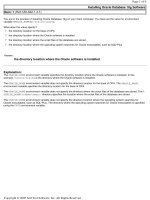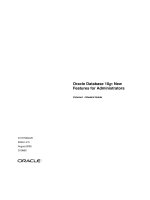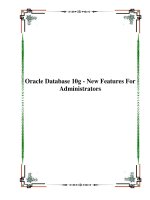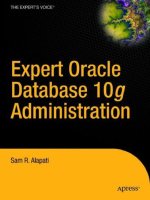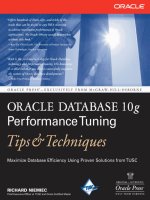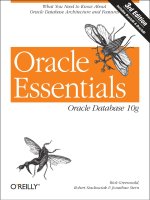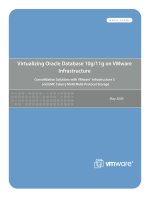Oracle Database 10g Real (RAC10g R2) on HP-UX Installation Cookbook phần 5 pot
Bạn đang xem bản rút gọn của tài liệu. Xem và tải ngay bản đầy đủ của tài liệu tại đây (867.79 KB, 10 trang )
Here we recommend only to the software and not to create a starter database. We will
create a database later with the Database Configuration Assistant.
6: The
Summary Page
displays the software components that the OUI will install and the
space available in the Oracle home with a list of the nodes that are part of the installation
session. Verify the details about the installation that appear on the Summary page and click
Install or click Back to revise your installation.
During the installation, the OUI copies software to the local node and then copies the
software to the remote nodes.
7: Then, OUI prompts you to run the root.sh script on all the selected nodes.
8. The OUI displays the
End of Installation
page, click Exit to exit the Installer.
9: You can check the installation with the command OCR commands
$ORA_CRS_HOME/bin/ocrdump, $ORA_CRS_HOME/bin/ocrcheck,
$ORA_CRS_HOME/bin/crs_stat. The crs_stat command will provide a description of the
Oracle environment available in the cluster.
# crs-stat -t
gives you a more compact output.
In addition we would recommend to copy the sample 10g CRS resource status query script
from the Oracle Metalink Note:259301.1:
#!/usr/bin/ksh
Page
41
of
51
HP/Oracle CTC RAC10g R2 on HP
-
UX cookbook
#
# Sample 10g CRS resource status query script
#
# Description:
# - Returns formatted version of crs_stat -t, in tabular
# format, with the complete rsc names and filtering keywords
# - The argument, $RSC_KEY, is optional and if passed to the script, will
# limit the output to HA resources whose names match $RSC_KEY.
# Requirements:
# - $ORA_CRS_HOME should be set in your environment
RSC_KEY=$1
QSTAT=-u
AWK=/sbin/awk # if not available use /usr/bin/awk
ORA_CRS_HOME=/opt/oracle/product/CRS
# Table header:echo ""
$AWK \
'BEGIN {printf "%-45s %-10s %-18s\n", "HA Resource", "Target", "State";
printf "%-45s %-10s %-18s\n", " ", " ", " ";}'
# Table body:
$ORA_CRS_HOME/bin/crs_stat $QSTAT | $AWK \
'BEGIN { FS="="; state = 0; }
$1~/NAME/ && $2~/'$RSC_KEY'/ {appname = $2; state=1};
state == 0 {next;}
$1~/TARGET/ && state == 1 {apptarget = $2; state=2;}
$1~/STATE/ && state == 2 {appstate = $2; state=3;}
state == 3 {printf "%-45s %-10s %-18s\n", appname, apptarget, appstate; state=0;}'
10: Oracle Disk Manager (ODM) Configuration: ODM is only required when using Oracle RAC
with CFS and SGeRAC.
Currently, there is a reported Oracle bug #5103839 with DBCA after enabling ODM (linking
the ODM library). The workaround is to create the database first and then link ODM.
l
Check that the VRTSodm package is installed.
# swlist VRTSodm
# VRTSodm 4.1 VERITAS Oracle Disk Manager
VRTSodm.ODM-KRN 4.1 VERITAS ODM kernel files
VRTSodm.ODM-MAN 4.1 VERITAS ODM manual pages
VRTSodm.ODM-RUN 4.1 VERITAS ODM commands
l
Check libodm.sl
# ll /opt/VRTSodm/lib/libodm.sl
-r-xr-xr-x 1 root sys 78176 May 20 2005 /opt/VRTSodm/lib/libodm.sl
l
Configure Oracle to use ODM: you need to link the Oracle Disk Manager library into
ORACLE_HOME for Oracle 10g (as oracle user):
¡
For Integrity systems:
$ rm ${ORACLE_HOME}/lib/libodm10.so
$ ln -s /opt/VRTSodm/lib/libodm.sl ${ORACLE_HOME}/lib/libodm10.so
¡
For PA-Risc systems:
$ rm ${ORACLE_HOME}/lib/libodm10.sl
$ ln -s /opt/VRTSodm/lib/libodm.sl ${ORACLE_HOME}/lib/libodm10.sl
l
Configure Oracle to Stop using ODM Library:
¡ For Integrity systems:
$ rm ${ORACLE_HOME}/lib/libodm10.so
# this only removes the symbolic link
to /opt/VRTSodm/lib/libodm.sl
$ ln -s ${ORACLE_HOME}/lib/libodmd10.so ${ORACLE_HOME}/lib/libodm10.so
¡
For PA-Risc systems:
Page
42
of
51
HP/Oracle CTC RAC10g R2 on HP
-
UX cookbook
10. Configure the Oracle Listeners
First we recommend to configure the Oracle Listener using the Oracle Net Configuration Assistant:
11. Create a RAC DB on CFS using Database Configuration
$ rm ${ORACLE_HOME}/lib/libodm10.sl
# this only removes the symbolic link
to /opt/VRTSodm/lib/libodm.sl
$ ln -s ${ORACLE_HOME}/lib/libodmd10.sl ${ORACLE_HOME}/lib/libodm10.sl
1: Connect as oracle user and start the Oracle Net Configuration Assistant by issuing the
command
$ netca &
Ensure that you have the DISPLAY set.
2: Select 'Cluster Configuration' and click Next.
3: The next screen lets you select the nodes for which to configure the Oracle listener. Select
all nodes, and click Next.
4: At the next page, select 'Listener configuration'
5: Select 'Add', and click Next.
6: Keep default name 'Listener', and click Next.
7: Keep 'TCP' as selected protocol, and click Next.
8: Keep standard protocol '1521', and click Next.
9: Say 'no', when you get asked to configure additional listener and Exit NetCa.
10: You can verify the Listener set-up through $ORA_CRS_HOME/bin/crs_stat (or the script
you downloaded at chapter 9, step 9):
$ /opt/oracle/product/CRS/bin$ ./crs_great
HA Resource Target State
ora.ksc.LISTENER_KSC.lsnr ONLINE ONLINE on ksc
ora.ksc.gsd ONLINE ONLINE on ksc
ora.ksc.ons ONLINE ONLINE on ksc
ora.ksc.vip ONLINE ONLINE on ksc
ora.schalke.LISTENER_SCHALKE.lsnr ONLINE ONLINE on schalke
ora.schalke.gsd ONLINE ONLINE on schalke
ora.schalke.ons ONLINE ONLINE on schalke
ora.schalke.vip ONLINE ONLINE on schalke
The listener names have now the syntax 'LISTENER_<nodename>':
$ lsnrctl status LISTENER_SCHALKE
11: As you can see in the listener configuration file
$ORACLE_HOME/network/admin/listener.ora, the Listener process is using the Oracle VIP
address.
Page
43
of
51
HP/Oracle CTC RAC10g R2 on HP
-
UX cookbook
Assistant
1: Connect as oracle user and start the Database Configuration Assistant by issuing the
command
$ dbca &
Ensure that you have the DISPLAY set.
2: The first page that the DBCA displays is the
Welcome
page for RAC. The DBCA displays
this RAC-specific Welcome page only if the Oracle home from which it is invoked was
cluster installed. If the DBCA does not display this Welcome page for RAC, then the DBCA
was unable to detect whether the Oracle home is cluster installed.
Select Real Application Clusters database, click Next.
3: At the
Configure Database Options
page select 'Create a database' and click Next.
4: At the
Node Selection
page select the nodes that you want to configure as members of
your cluster database, then click Next.
5: The templates on the
Database Templates
page are Custom Database, Transaction
Processing, Data Warehouse, and General Purpose. The Custom Database template does
not include datafiles or options specially configured for a particular type of application.
Select the General Purpose template for your cluster database, and click Next.
6: At the
Database Identification
page enter the global database name and the Oracle
system identifier (SID) prefix for your cluster database and click Next.
The SID prefix must begin with an alphabetical character and contain no more than 5
characters on UNIX-based systems.
7: On the
Management Options
page, you can choose to manage your database with
Enterprise Manager. On UNIX-based systems only, you can also choose either the Grid
Control or Database Control option if you select Enterprise Manager database
management. If you select Enterprise Manager with the Grid Control option and DBCA
discovers agents running on the local node, then you can select the preferred agent from a
Page
44
of
51
HP/Oracle CTC RAC10g R2 on HP
-
UX cookbook
list.
Here, do the following selection, and click Next.
8: The the
Database Credentials
page you can enter the passwords for your database. You
can enter the same or different passwords for the users SYS and SYSTEM, plus DBSNMP
and SYSMAN if you selected Enterprise Manager on the Management Options page.
9: At the
Network Configuration
page select 'Register this database with all the listeners'.
10: At the
Storage Options
page you can select a storage type for the database. Please select
the storage option that applies to your chosen deployment model.
Here, we show an installation for HP SG CFS for RAC.
Page
45
of
51
HP/Oracle CTC RAC10g R2 on HP
-
UX cookbook
11: On the
Recovery Configuration
page, you can specify the Flash Recovery Area and
Enable Archiving.
To use a flash recovery area, Oracle recommends that you create two separate disk
groups: one for the database area and one for the recovery area.
12: On the
Database Content
page, you can select whether to include the sample schemas in
your database and to run custom scripts as part of the database creation processing.
13: To create services on the
Database Services
page, expand the Services tree. Oracle
displays the global database name (here GRID) in the top left-hand corner of the page.
Select the global database name and click Add to add services to the database (here
GRID1 and GRID2).
On the right-hand you see the service preferences for each service. Change the instance
preference (Not Used, Preferred, or Available) and TAF policies for the service as needed.
Repeat this procedure for each service and when you are done configuring services for
your database, click Next.
14: At the
Initialization Parameters
page you can review and adjust the initialization
parameters.
15: If you selected a preconfigured database template, such as the General Purpose template,
then the DBCA displays the control files, datafiles, and redo logs on the
Database Storage
page. Select the folder and the file name underneath the folder to edit the file name.
After you complete your entries on the Database Storage page, click Next.
16: On the
Creation Options
page, select Create Database and click Finish. You can also
Page
46
of
51
HP/Oracle CTC RAC10g R2 on HP
-
UX cookbook
12. Oracle Enterprise Manager 10g Database Control
When you are installing the database software, the OUI also installs the software for Oracle
Enterprise Manager Database Control and integrates this tool into your cluster environment. Once
installed, Enterprise Manager Database Control is fully configured and operational for RAC. You
can also install Enterprise Manager Grid Control onto other client machines outside your cluster to
monitor multiple RAC and single-instance Oracle database environments.
save this configuration as a database template file and use this template later to create a
database.
17: Review the
Summary
dialog information and click OK to create the database.
Change the db account password if necessary and click Exit.
18: Congratulations you have now your RAC database configured :-)
19: You can check the installation with the command $ORA_CRS_HOME/bin/crs_stat. This
command will provide a description of the Oracle environment available in the cluster.
1: Start the DBConsole agent on one of the cluster nodes as Oracle user:
Page
47
of
51
HP/Oracle CTC RAC10g R2 on HP
-
UX cookbook
13. Implementation of SG Packages Framework for RAC 10g
HP offers an Oracle Integration Framework which contains a set of templates that can be used to
help integrate Oracle RAC10g R2 with SGeRAC version 11.17.
This framework provides a uniform, easy-to-mange and intuitive method to
l
co-ordinate the operation of this combined software stack
l
manage all the storage options supported – SLVM, CFS/CVM and ASM over SLVM
The included templates are based on the following two new Serviceguard features introduced with
11.17:
l
Multi-Node Package (MNP):
¡
SG Package manager enhanced to allow a package to run on more than one node at
once.
n
Each instance of a multi-node package behaves as a normal package but does
not failover.
n
Overall package status is a summary of the status of package instances.
¡
Commands enhanced to manage multi-node packages
n
cmrunpkg/cmhaltpkg enhanced to allow multiple –n parameters to be specified.
n
cmviewcl adds new display format for multi-node packages
l
Simple Dependency
$ emctl start dbconsole (other options: emctl start| stop| status| setpasswd
dbconsole)
2: To connect to the Oracle Enterprise Manager Database Control (default port 5500) open
the following URL in our web browser:
http://<node1a>:1158/em
3. Log-in as sys and sysdba profile.
4. Accept the licensing.
4. Now you will get to the OEM Database Control Home Page.
Page
48
of
51
HP/Oracle CTC RAC10g R2 on HP
-
UX cookbook
¡
Enforce package start/halt ordering
¡
If A depends on B and B fails, A is halted
This integration between SGeRAC and RAC10g can be configured as shown here:
The use of the framework is restricted to a maximum SGeRAC cluster size of 8 nodes.
The framework may not be used in Extended Cluster, Metrocluster or Continentalclusters
configurations.
13.1 Configuration of Framework
l
Assume SGeRAC, Oracle clusterware and RAC database(s) are already installed and
configured
l
Configure Oracle clusterware and the RAC database instances to be started on demand,
instead of being automatically started:
¡
Disable Oracle clusterware startup on boot
¡
Disable auto-start of RAC db instances by CRS
¡
See Oracle Metalink Note:298073.1
l
Halt the databases and Oracle Clusterware
l
Configure the framework, using the script bundle delivered by HP's ACSL organization and
follow instructions in the README file in the script bundle.
¡
This scripts can be downloaded from the HP internal web page at
A
more detailed white paper can be found at
/>¡
In the package directory, copy the framework files for Oracle Clusterware or the RAC
instance
¡ Configure the RAC10g specific logic of the MNP in the framework configuration file.
¡
Distribute the framework files to the other nodes of the MNP using remote copy
commands.
Page
49
of
51
HP/Oracle CTC RAC10g R2 on HP
-
UX cookbook
¡
In the package directory, create SGeRAC package templates using cmmakepkg, and
configure the SGeRAC specific part of the MNP in the package configuration and
control script files
¡
Apply the package configuration using the cmcheckconf - cmapplyconf sequence.
14
.
Tips & Tricks
Oracle Clusterware:
l
CRS and 10g Real Application Clusters; Oracle Metalink Note: 259301.1
l
How to start the 10g CRS ClusterWare; Oracle Metalink Note Note:309542.1
l
How to Clean Up After a Failed CRS Install; Oracle Metalink Note:239998.1
l
How to Stop the Cluster Ready Services (CRS); Oracle Metalink Note:263897.1
l
Stopping Reboot Loops When CRS Problems Occur; Oracle Metalink Note: 239989.1
l
Troubleshooting CRS Reboots; Oracle Metalink Note:265769.1
l
CRS 10g Diagnostic Collection Guide; Oracle Metalink Note:272332.1
l
What Are The Default Settings For MISSCOUNT In 10g RAC ?, Oracle Metalink Note
300063.1
l
CSS Timeout Computation in 10g RAC 10.1.0.3; Oracle Metalink Note:294430.1
l
HOW TO REMOVE CRS AUTO START AND RESTART FOR A RAC INSTANCE; Oracle
Metalink Note:298073.1
VIPs / Interconnect / Public Interface:
l
Configuring the HP-UX Operating System for the Oracle 10g VIP; Oracle Metalink
Note:296874.1
l
How to Configure Virtual IPs for 10g RAC; Oracle Metalink Note:264847.1
l
How to change VIP and VIP/Hostname in 10g ; Oracle Metalink Note:271121.1
l Modifying the VIP of a Cluster Node; Oracle Metalink Note:276434.1
l
How to Change Interconnect/Public Interface IP Subnet in a 10g Cluster; Oracle Metalink
Note:283684.1
l Troubleshooting TAF Issues in 10g RAC; Oracle Metalink Note:271297.1
l
Oracle 10g VIP (Virtual IP) changes in Oracle 10g 10.1.0.4; Oracle Metalink Note:296878.1
OCR / Voting:
l
How to Restore a Lost Voting Disk in 10g; Oracle Metalink Note:279793.1
l
Repairing or Restoring an Inconsistent OCR in RAC; Oracle Metalink Note:268937.1
ASM:
l
ASM Instance Shuts Down Cleanly On Its Own; Oracle Metalink Note:277274.1
Migration:
l
How to migrate from 9iRAC to RAC10; CTC Technical Paper
Adding/Removing Nodes:
l
Adding a Node to a 10g RAC Cluster; Oracle Metalink Note: 270512.1
l
Removing a Node from a 10g RAC Cluster; Oracle Metalink Note:269320.1
Page
50
of
51
HP/Oracle CTC RAC10g R2 on HP
-
UX cookbook


